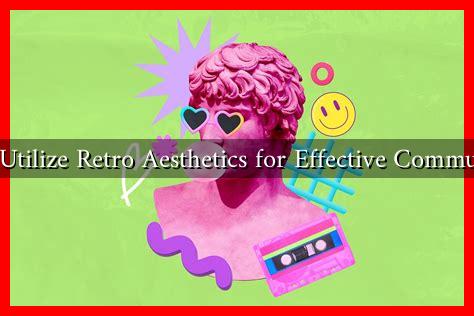-
Table of Contents
- How to Utilize Retro Aesthetics for Effective Communication
- The Power of Nostalgia
- Understanding Retro Aesthetics
- Strategies for Effective Communication Using Retro Aesthetics
- 1. Identify Your Audience
- 2. Choose the Right Visual Elements
- 3. Create Engaging Content
- Case Studies: Successful Implementation of Retro Aesthetics
- Conclusion
How to Utilize Retro Aesthetics for Effective Communication
In an age dominated by sleek, modern designs and digital interfaces, retro aesthetics have emerged as a powerful tool for effective communication. By tapping into nostalgia and familiar visual cues, brands and individuals can create messages that resonate deeply with their audiences. This article explores how to effectively utilize retro aesthetics in communication, providing insights, examples, and strategies to enhance your messaging.
The Power of Nostalgia
Nostalgia is a potent emotion that can evoke strong feelings and memories. According to a study published in the journal *Emotion*, nostalgia can enhance mood, increase social connectedness, and even improve self-esteem. By leveraging retro aesthetics, communicators can evoke these feelings, making their messages more impactful.
Understanding Retro Aesthetics
Retro aesthetics refer to design elements that draw inspiration from past styles, often characterized by vibrant colors, vintage typography, and iconic imagery. These elements can be found in various forms, including:
- Graphic design (posters, logos, and packaging)
- Web design (color schemes, fonts, and layouts)
- Advertising (commercials and print ads)
- Social media content (posts and stories)
By incorporating these elements, communicators can create a sense of familiarity and comfort, making their messages more relatable.
Strategies for Effective Communication Using Retro Aesthetics
To effectively utilize retro aesthetics in your communication, consider the following strategies:
1. Identify Your Audience
Understanding your target audience is crucial. Different generations have varying associations with retro styles. For example:
- Baby Boomers may resonate with 1960s and 1970s designs.
- Generation X might connect with 1980s and 1990s aesthetics.
- Millennials and Gen Z often appreciate early 2000s nostalgia.
Tailoring your retro elements to your audience can enhance engagement and effectiveness.
2. Choose the Right Visual Elements
Select visual elements that align with your message and brand identity. Consider:
- Color palettes: Soft pastels for a vintage feel or bold colors for a retro pop.
- Typography: Use fonts that reflect the era you’re drawing from, such as serif fonts for a classic look or playful scripts for a whimsical touch.
- Imagery: Incorporate iconic symbols or patterns that evoke the desired time period.
For instance, Coca-Cola’s use of retro branding in their advertisements has successfully evoked nostalgia while maintaining brand recognition.
3. Create Engaging Content
Utilize storytelling to enhance your communication. Retro aesthetics can serve as a backdrop for narratives that resonate with your audience. For example:
- Share personal stories or testimonials that reflect the values of the past.
- Use retro-themed visuals in social media campaigns to create a cohesive narrative.
- Incorporate vintage music or sound effects in videos to enhance the nostalgic experience.
Brands like Airbnb have successfully used retro aesthetics in their marketing campaigns to evoke a sense of adventure and nostalgia for travel.
Case Studies: Successful Implementation of Retro Aesthetics
Several brands have effectively utilized retro aesthetics to enhance their communication strategies:
- Pepsi: The brand’s “Pepsi Generation” campaign in the 1960s and 1970s used vibrant colors and bold typography to appeal to a youthful audience, creating a lasting impact.
- Netflix: The marketing for the series *Stranger Things* heavily relies on 1980s nostalgia, using retro visuals and music to attract viewers who grew up in that era.
- Instagram: The platform’s retro filters allow users to create vintage-style photos, tapping into the nostalgia trend and enhancing user engagement.
Conclusion
Utilizing retro aesthetics in communication can create a powerful connection with your audience, evoking nostalgia and enhancing engagement. By understanding your audience, choosing the right visual elements, and crafting engaging content, you can effectively leverage retro styles to communicate your message. As demonstrated by successful brands, retro aesthetics not only capture attention but also foster emotional connections that can lead to lasting loyalty. Embrace the past to communicate effectively in the present.
For further reading on the impact of nostalgia in marketing, check out this article on Forbes.

